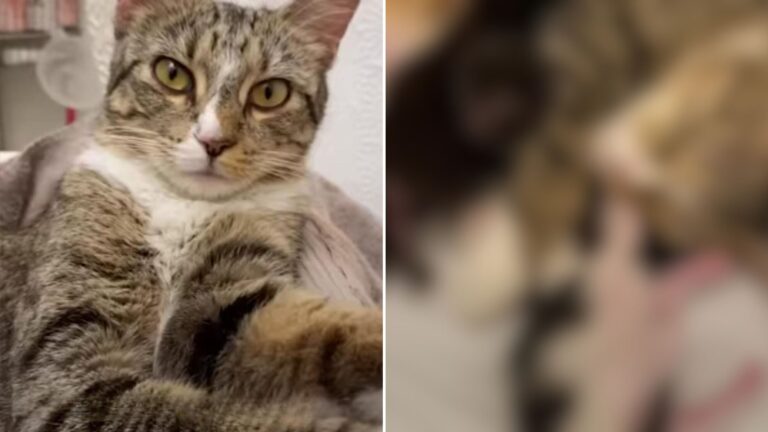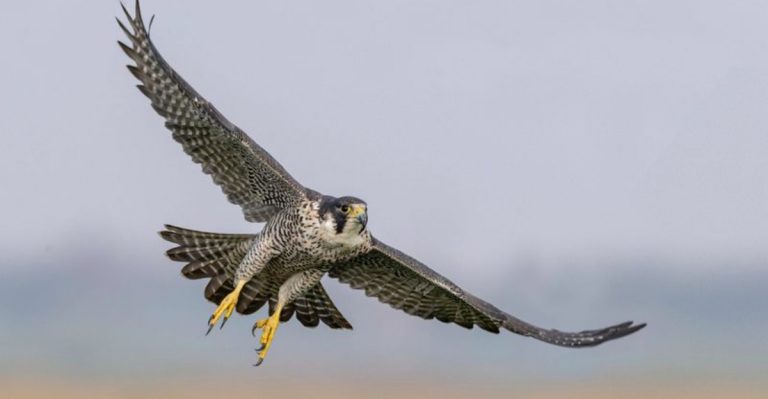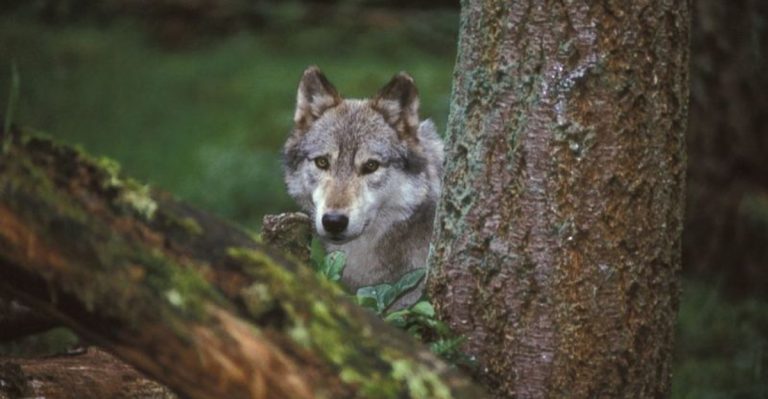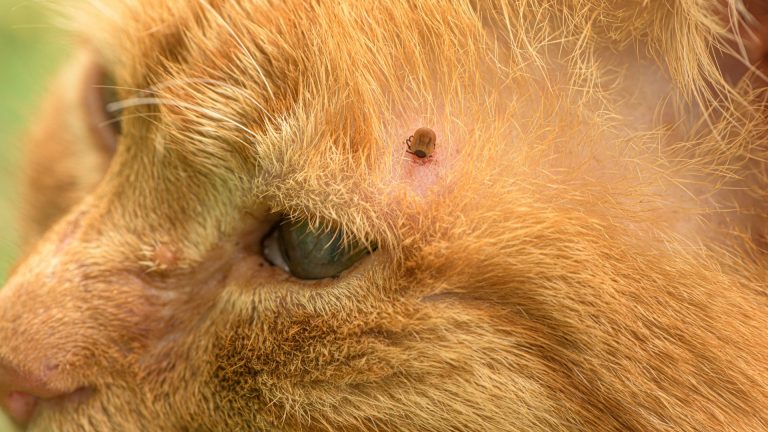Battle Of Floofs: Himalayan Vs Ragdoll Cat
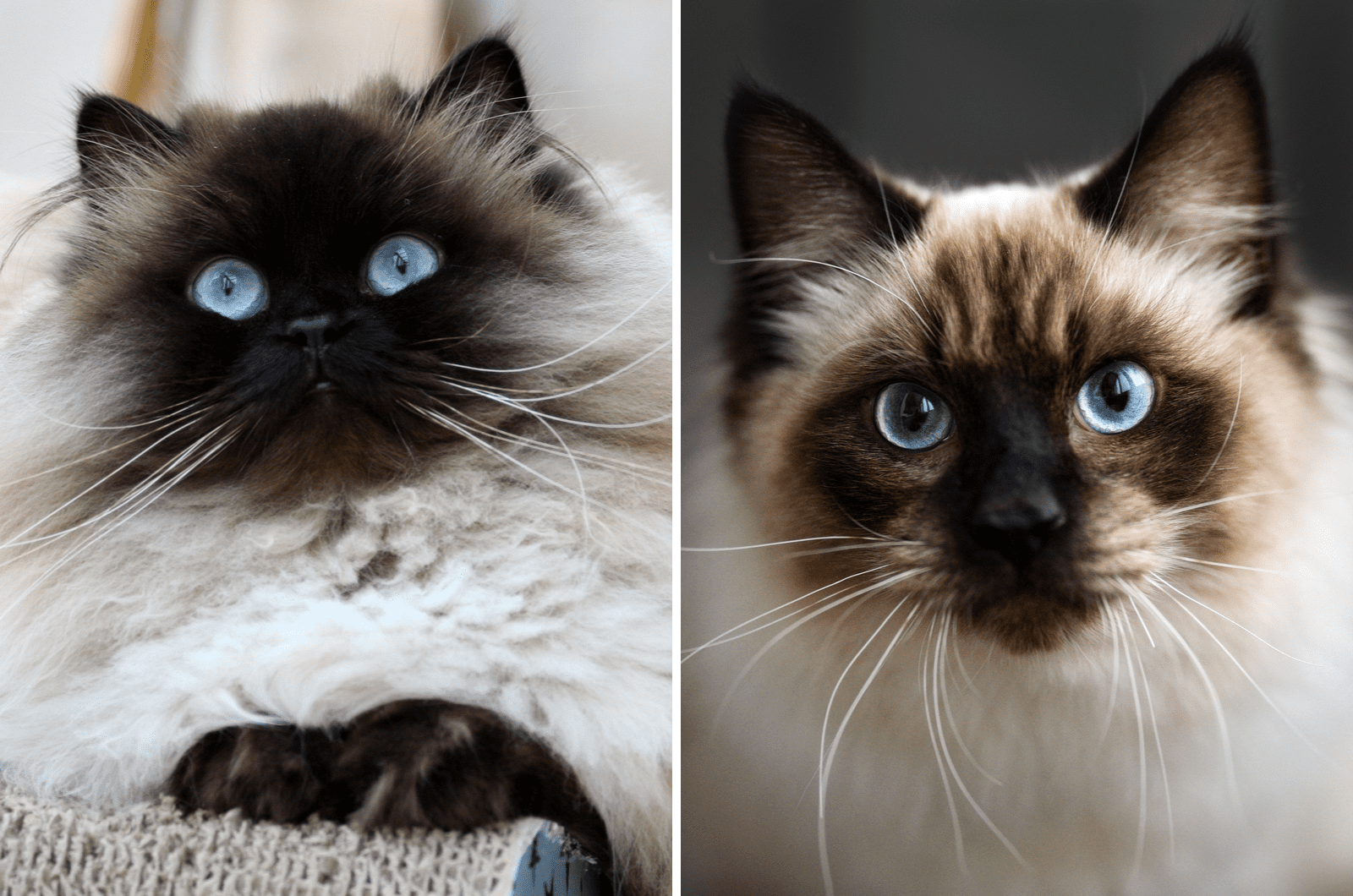
Both of these breeds are very popular due to their unique looks and amazing (but different) personalities.
I completely understand why people get confused about these two breeds. On the outside, a Himalayan cat and a Ragdoll cat look almost identical!
They’re both usually white, with some parts of their face being a dark brown or a black color. Their eyes really stand out, as they are usually blue and very beautiful.
But apart from the obvious appearance similarity at first glance, they have some obvious differences.
Continue reading to find out the details of all the differences between these two cat breeds.
Himalayan Vs Ragdoll Cat – Similarities and Differences
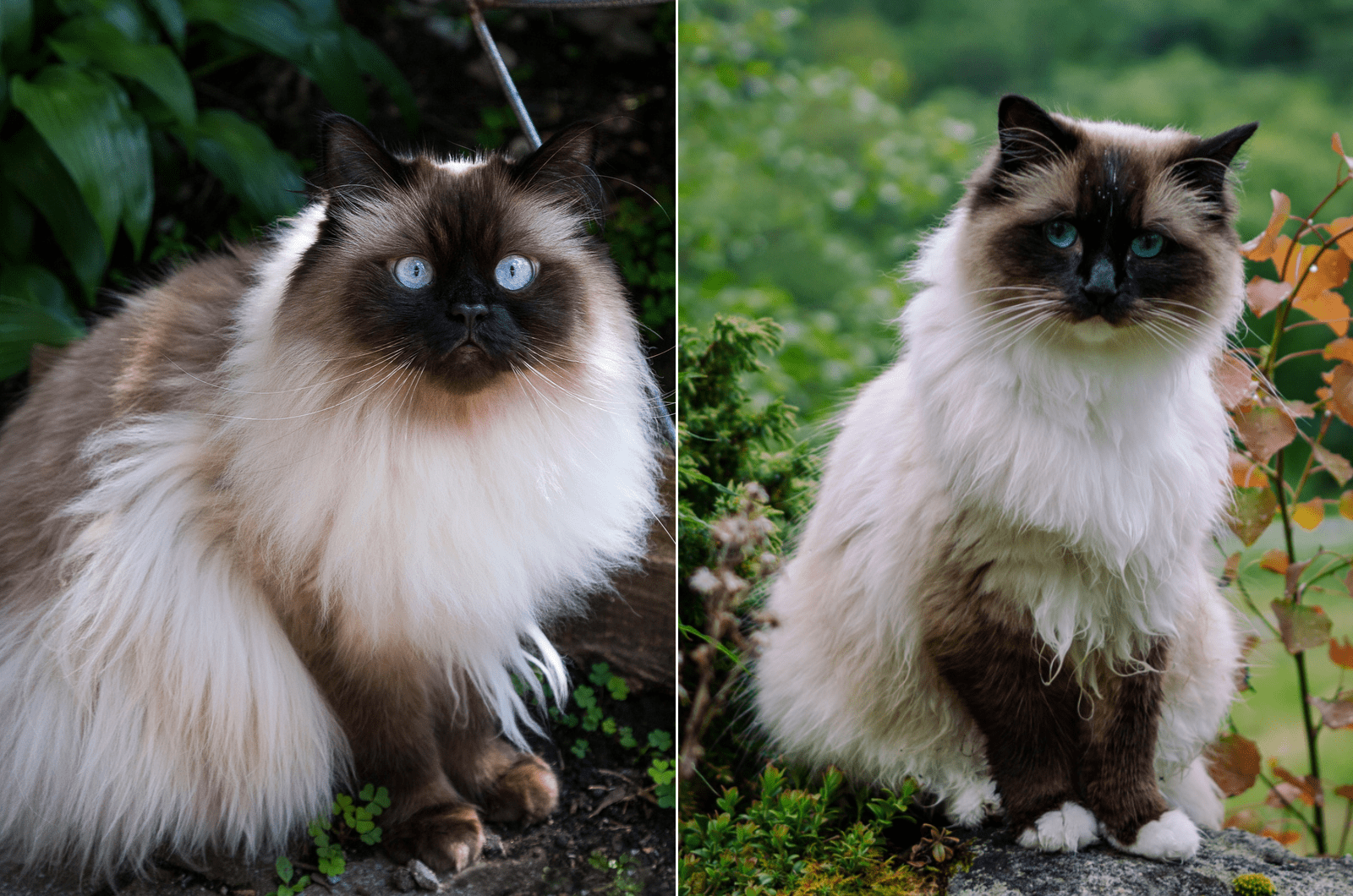
As you will see below, these two cat breeds have a lot of things in common, but also some differences.
Both are among the most popular cat breeds, both are longhaired cats, are very friendly and social, making for the perfect pets!
These two breeds of cats are often mixed up due to their extremely similar outer appearance. Both are usually white with darker areas on their paws, tail, ears and/or face. But the most prominent difference is their face shape, as well as their size difference (Ragdoll cats tend to be larger).
But their ancestry, fur type, need of maintenance, health issues, and some other features are very much different!
Continue reading to learn exactly what makes these two cats separate cat breeds!
19 Features Compared Between The Two Breeds
Below, I have compared the Himalayan and Ragdoll cats based on 19 different features. I hope you’ll enjoy it and learn something new!
1. Ancestry & History
Himalayan Cat
The Himalayan cat is “the result” of crossing a Persian cat with a Siamese cat!
They were created in the 1930s by Dr. Clyde Keeler and Virginia Cobb. They were working on cross breeding a Persian and a Siamese cat. The first Himalayan cat was actually the fourth generation of crossbreeding the two mentioned breeds.
The name Himalayan came from the scientist who was reminded of the rabbits and goats that live in the Himalayas when considering the obtained cat.
Over the years, the Persian side was strengthened by breeding attempts, so many people tend to call the Himalayan cat a sub-version of the Persian cat.
Ragdoll Cat
The origins of this cat breed are a bit of a mystery. Ragdoll cats are most probably “a mix” of a Birman cat, a Persian cat and a Burmese cat.
The origin of the Ragdoll cat is relatively recent and it all started with a Californian cat-breeder named Ann Baker in the 1960s. She developed the first Ragdoll by breeding an Angora cat (called Josephine) with a seal Point Birman cat. Then, one of the male offsprings was bred with a Burmese cat, resulting in the Ragdoll cat being born.
All Ragdoll cats today are the descendants of Josephine. In the United States, every breeding Ragdoll cat can be traced back to Josephine.
Two Quick Popular Stories About The Origin Of The Ragdoll Cat
There are two stories circulating on the internet.
First one being that Ann Baker actually “accidentally” created the Ragdoll cat, since Josephine (her white Angora cat) was not purposely mated with a Birman cat. But soon after birth, Ann noticed the litter was different from the previous litters Josephine produced, and then she continued breeding the kittens, eventually creating the Ragdoll cat we know now.
The second one is that Josephine, an Angora cat Ann Baker owned, was hit by a car and taken to the hospital, where government testing was done on the cat. After that, Josephine did not feel any pain and was very relaxed when being picked up. The next litter Josephine produced inherited the same features. That’s why all Ragdolls now are very relaxed, calm, and gentle.
I’m sure these stories are interesting to you, but do you think they seem true?
2. Facial Features
Himalayan Cat
Himalayan cats have two very distinctive facial features, which make this breed very unique-looking. They have flat faces and full cheeks.
Himalayan cats can have one of two facial variations:
🐾 Doll-face or “traditional”
🐾 Peke-face or “extreme”
Both doll-face and peke-face mean squashy–looking faces, but the face is more squashed (more flat) in peke–face Himalayan cats.
Ragdoll Cat
When it comes to Ragdoll cats, they do not have distinctive facial features like Himalayan cats do.
Ragdoll cats have, well, typical cat faces. Their faces are triangular and their nose is not flat like those of Himalayan cats, but rather just like in any other cat.
3. Weight And Height
Himalayan Cat
Himalayan cats usually weigh from 7–12 pounds, while some males may weigh a bit more. Adult Himalayan cats are 10–12 inches (25–30cm) tall and they’re considered a medium-sized cat. They might appear as large-sized cats, but that’s because their fur makes them look huge.
Ragdoll Cat
This breed is considered as one of the largest cat breeds. An adult female can weigh up to 15 pounds, while males can go as high as 20 pounds (or even more!).
They don’t reach their full size for a couple of years.
They’re usually 9–11 inches tall (23–28cm)
Because of their size and muscular build, they might be confused with Maine Coons.
4. Fur Features
Himalayan Cat
They are longhaired cats and have VERY thick and fluffy fur. Even though they are medium-sized cats, they appear very large because of their fur.
They have a double coat and, due to that and their hair being long, they absolutely need daily fur maintenance.
Ragdoll Cat
In contrast, Ragdoll cats do not have a double coat and do not need extra fur–care. Their coat maintenance is minimal, which surely cannot be said for Himalayan cats.
They’re semi-longhaired with beautiful silky and soft fur. Some say this breed has the best fur out of all cat breeds, and many people love them for it.
5. Fur Color
Both Himalayan and Ragdoll can have the following fur colors:
🐾 Cream – having a light beige tail and ear tips, as well as paws
🐾 Chocolate – having a dark ivory color that fades at some points
🐾 Seal – having a very deep brown face, ears, tail, and paws, that fades into white
🐾 Lilac – having a white body with a warm-gray face, ears, tail, and paws
🐾 Red – having a pale red tail and ear tips, as well as paws
🐾 Blue – a slightly darker version of lilac fur
Himalayan Cat
The majority of Himalayan cats are either a white or a cream color, but other options are possible as well (listed above). The rarest fur color for this cat breed is lilac.
Ragdoll Cat
The “traditional” Ragdoll cat is a seal point Ragdoll. As for the rarest fur color, the case is the same for Himalayan cats. Lilac Ragdoll cats are the rarest.
But did you know that Ragdoll cats are born all white, and their fur color at specific areas (notably face, ears, tail, and paws) develops after their second year of life? Their full fur color is set only at the age of 3–4 years.
A Fun Fact About The Fur Of Ragdoll Cats
Ragdoll cats are famous for “changing colors”. Their coat color almost entirely depends on the temperature of the cat’s body. Of course, it does not happen in two minutes, but rather during a couple of weeks (or even months).
The bi-color of Ragdoll cat’s fur is very interesting.
Pigment production, and therefore fur color, depends on an enzyme that depends on the body temperature. The lower the temperature, the more the enzyme works and deposits pigment. On the other hand, higher temperatures means lower pigment production and the lighter the fur color.
Because of this, Ragdoll cats are always darker on their paws, tails, ears, and mouth – essentially in areas where their body temperature is lower.
6. Coat Pattern
Himalayan Cat
Himalayan cats can come with the following coat patterns:
🐾 Tabby – stripes, spots, random patches of color throughout the coat
🐾 Tortoiseshell – pattern of intertwining black, ginger, and white patches of fur
🐾 Lynx – darker stripes on paws
Ragdoll Cat
Ragdolls come in four different patterns:
🐾 Colorpoint – darker fur on paws, tail, ears and face
🐾 Mitted – looks as if the cat’s wearing mittens, clear white patches on the paws
🐾 Bi-color – an “inverted V” white patch of fur on the face
🐾 Lynx – very similar to a tabby pattern, stripe patterns along the body
7. Eyes
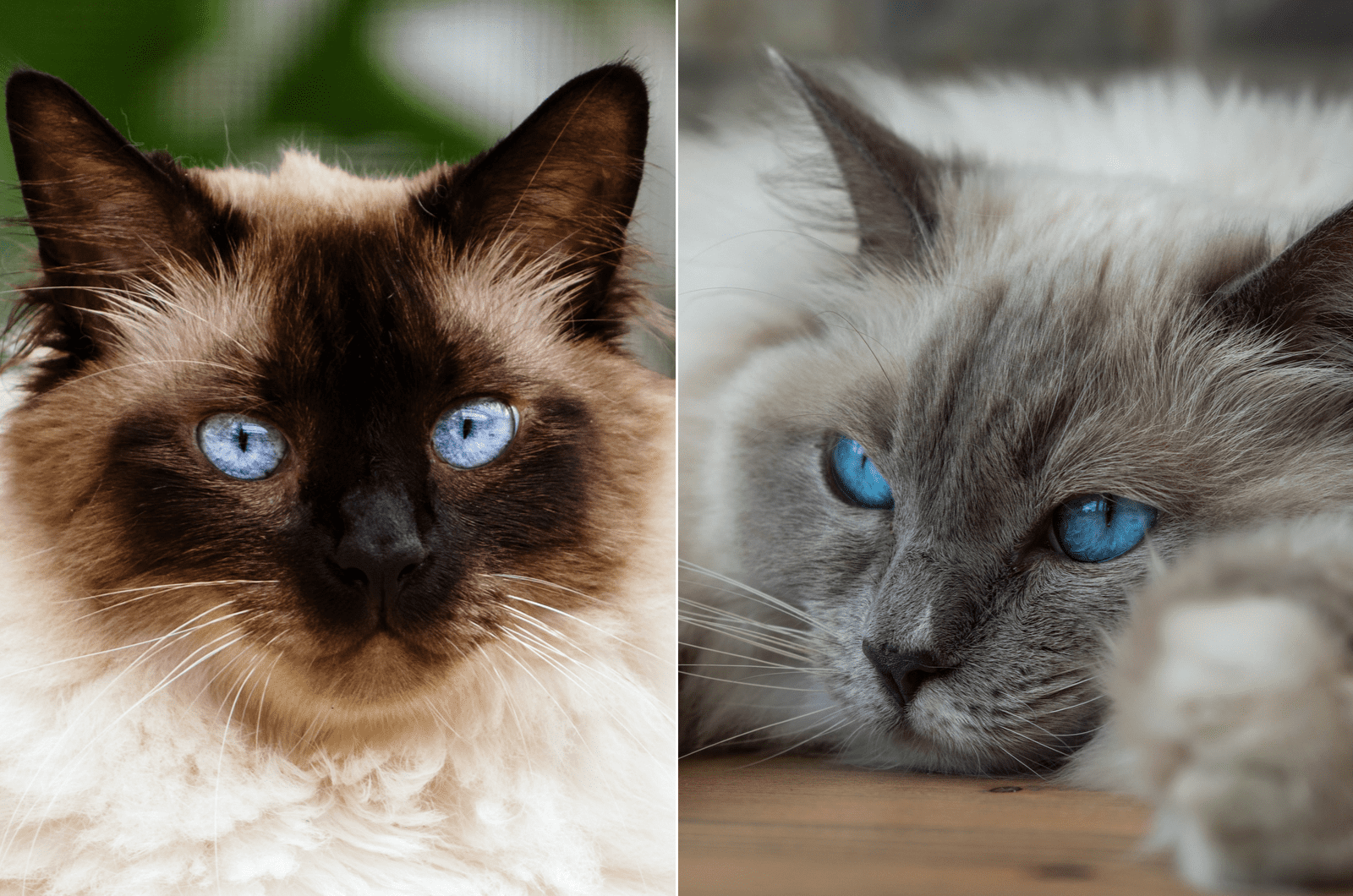
Himalayan Cat
Himalayan cats’ most distinctive feature is their beautiful, piercing–blue eyes. No other eye colors have been noted thus far.
Ragdoll Cat
Traditional Ragdoll cats also have bright blue, oval eyes. The color can be any shade from pale blue to dark blue.
Mixed breed Ragdoll cats don’t necessarily have blue eyes, even though most do.
Summary: Comparison Of The Physical Appearance Features
Here, I have a short summary of everything written above:
[table id=5 /]
8. Personality
Himalayan Cat
Himalayan cats (or Himmies as some people call them) are known for being very sweet, laid back, and calm. Their gentle nature makes them the most perfect quiet companion, if you want one like that. They will not cause much trouble and they absolutely love affection!
Ragdoll Cat
Ragdoll cats (or Raggies) share a lot of their personality traits with the Himalayan cats. They are also very calm, earning them the nickname Gentle Giants. They are very sweet, relaxed, and tolerant. This makes them perfect for families with kids and other pets in the household.
It is said that they have “floppy personalities” and “dog–like behavior”. This is because they are so relaxed that they go limp when being picked up. They seem not to mind nor care at all that they’re up in the air and not on their four paws.
They are also a famous breed because they act like dogs. They’re affectionate but not too demanding, while being extremely loyal –- just like dogs.
9. Energy Levels
Himalayan Cat
They are very …low energy cats. They are very calm cats that will not create mess in the house, nor cause any trouble. They will not be couch–bound, but they will simply “take it easy”.
Ragdoll Cats
Ragdoll cats, as well as Himalayan cats, are not very energetic. But even if they’re not very active, it does not mean they will lie around and sleep the entire day every day. They still need their playtime and mental stimulation, so do not forget about that!
10. Exercise Needs
Both Himalayan and Ragdoll cats do not need much exercise. Considering they are not very active in the first place, they are not likely to have extra energy to spend on some exercises.
But even though they do not need physical exercise, they do need mental stimulation via toys and games. So using toys will stimulate them mentally, but also provide them with some physical activity.
Because of this shared feature, both cat breeds are well-adjusted to living in an apartment.
11. Need For Affection
Both cat breeds are very affectionate and absolutely love cuddling! They can often be found licking and following their owners, rubbing themselves on them and jumping in their lab whenever they get the chance.
Not only do they like affection, they actually need affection. Both cat breeds are quite dependent on their human friends and love their companionship, especially the owner’s.
Sometimes, they can exhibit their clingy side, but it is nothing too alarming.
12. Friendliness
Himalayan and Ragdoll cats are both VERY friendly and love the company of humans and other pets. They are prone to forming an attachment towards one person or even to an entire household. They never display aggressiveness and are welcoming to new family members or new pets.
Both cat breeds are very social, liking company and attention, but they aren’t very clingy (even though some might be). They are amazing with kids and other pets, which makes sense considering they’re very calm and gentle breeds.
13. Playfulness
Himalayan Cat
Even though you might expect Himalayan cats to be very lazy, they are not! Yes, they do look very big and are not very energetic by nature, but that does not mean they will lay on the sofa the entire day.
They are very playful when they want to be and enjoy mental stimulation. You will most likely observe bursts of energy and a subsequent need for a little bit of rest.
Ragdoll Cat
The same goes for Ragdoll cats. They will never say No to some interesting toys, but in general, they’re not the most active cat breed. This actually suits some cat owners, especially those who do not have a lot of time to play with their pets.
14. Intelligence And Trainability

Himalayan Cat
Himalayan cats are smart, but are definitely not within the smartest cat breeds. They can be taught some simple commands.
Ragdoll Cat
Ragdoll cats are intelligent cats that are pretty easy to train. They can pick up some tricks and commands quickly.
Summary: Comparison Of Personality Features
[table id=4 /]
15. Grooming Needs
Himalayan Cat
Himalayan cats have A LOT of hair. They have a double coat and are longhaired – and that means a lot of daily maintenance is needed.
They need to be bathed every two to three months, but brushed daily. Regular maintenance of their fur is crucial in preventing mats and tangles that will appear if they’re not brushed daily. Matting and tangling can be solved only by brushing or combing them through.
Ragdoll Cat
On the other hand, Ragdoll cats are not in need of that much maintenance. They do not have a double coat, so their fur is not as thick as that of Himalayan cats.
They need to be brushed a minimum of three times a week and bathed every four to six weeks. That makes them pretty low maintenance cats, especially compared to Himalayan cats.
16. Shedding
Himalayan Cat
Well, as you might expect, Himalayan cats shed quite a lot and it’s all due to their undercoat. The presence of an undercoat is the cause of excessive and daily shedding.
It’s very noticeable during spring and summer, but there are ways to keep it under control. Daily grooming is a must! It removes loose hair, so you will not find many fur balls around the house
Ragdoll Cat
Ragdoll cats also need grooming, but it doesn’t have to be daily. They also shed, but not as much as Himalayan cats.
17. Health Issues
Himalayan Cat
Himalayan cats are known to have respiratory issues due to their facial composition (having a compacted snout), but some other issues are common too.
These are the most common diseases Himalayan cats carry:
🐾 Upper respiratory issues (due to their flat faces) such as difficulty breathing
🐾 Polycystic kidney disease.
🐾 Heart disease
🐾 Feline asthma
🐾 Cherry eye
🐾 Dental issues
Ragdoll Cat
Ragdoll cats are relatively healthy cats. They don’t suffer from a lot of diseases. But some are more prevalent than others, such as:
🐾 Polycystic Kidney Disease
🐾 Gum Disease
🐾 Obesity
🐾 Urinary Tract Infections
🐾 Hypertrophic cardiomyopathy
18. Lifespan
Himalayan Cat
The average lifespan of Himalayan cats is 9–15 years.
Ragdoll Cat
Healthy Ragdoll cats can live anywhere from 12–20 years, while some surpass 20 years of age. The average life expectancy is around 15 years.
19. Cost
The cost of a cat always depends on where you get them. Is it from a shelter or from a well-known breeder? Purebred cats are always more expensive than mixed cats, so expect to spend some more on a purebred cat, such as a Himalayan or a Ragdoll cat.
Himalayan Cat
Himalayan kittens can cost anywhere from $200–$2500. They are in high demand, so expect the actual price to be at the higher end of the range.
Ragdoll Cat
Ragdoll kittens can cost anything up to $2000, even though some very well respected and reputable breeders can list them for more than $2000.
Summary: Comparison Between Breed Needs
[table id=3 /]
What Do CFA And TICA Think Of The Two Breeds?
CFA stands for Cat Fanciers Association, while TICA stands for The International Cat Registry. They’re both USA-based cat registering organizations. CFA is the largest cat registry, but TICA is growing rapidly. They have many differences, but both essentially deal with registering purebred cats.
CFA recognized Ragdoll cats as an official breed in 1998 and continues to do so today.
When it comes to Himalayan cats, there have been some controversies. They were first recognized as an official breed by the CFA, but in 1984, they were re–classified as a variety of a Persian cat.
TICA also classified the Himalayan cat a part of the Persian cat group, while the Ragdoll is recognized as a distinct cat breed.
Cat breeders usually register their cats with both organizations.
Which Breed Would Make For A Better Pet?
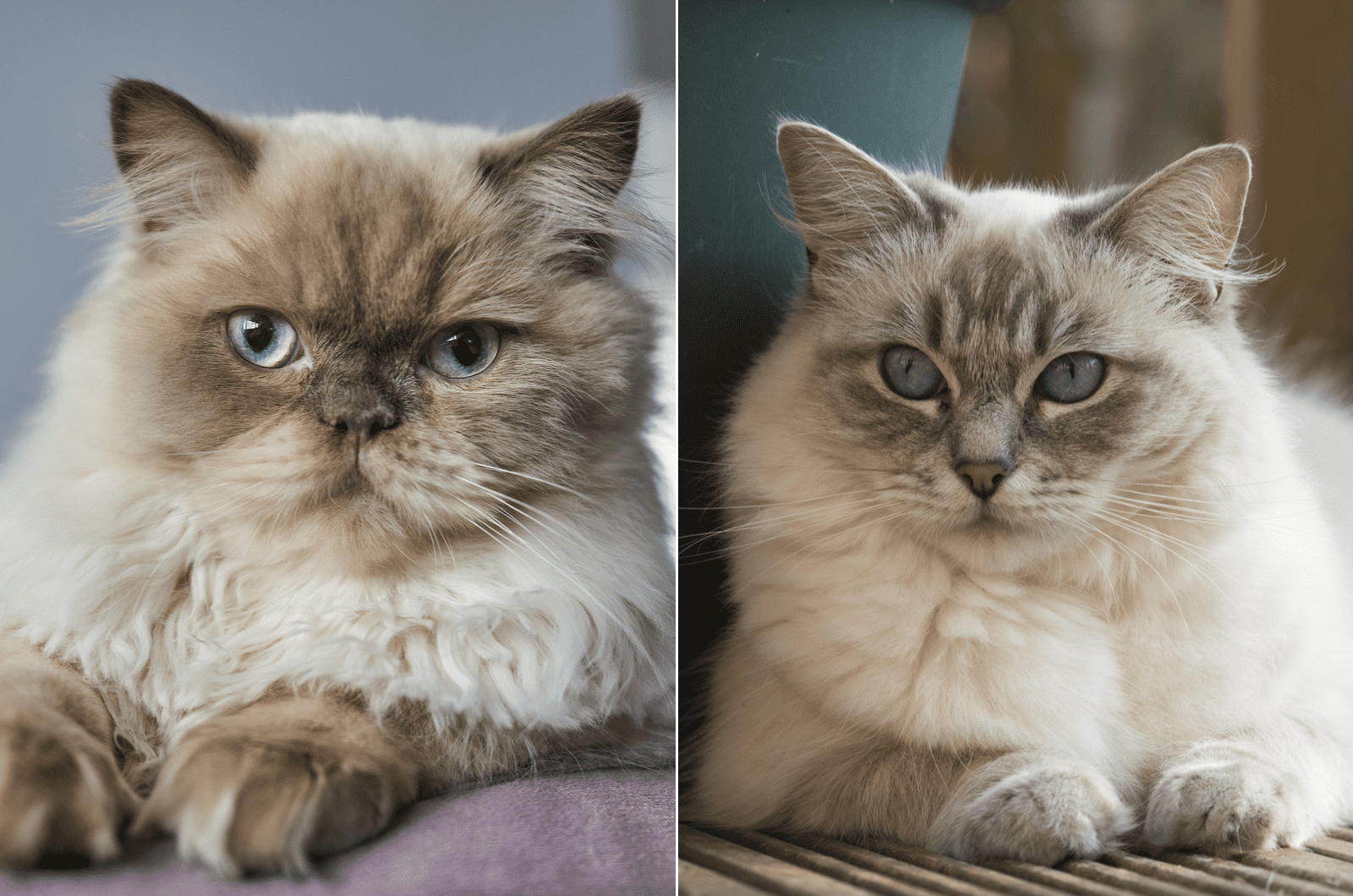
Himalayan cats and Ragdoll cats are purebred domestic cats that would both make amazing pets! But not every breed suits every person.
For example, future owners that are not ready to deal with the shedding and daily grooming of the Himalayan cat should not get this cat as a pet. For them, a Ragdoll might be a better choice, even though they also aren’t completely maintenance–free.
But other than that, they are both wonderful pets to have, they love families and are great with kids and other pets.
They are not high–maintenance as they don’t ask for a lot of attention or daily activities. They’re both great cuddle–partners and I’m sure both cats are amazing pets!
In Conclusion
I’m sure you will now know how to differentiate between the two cats. They have some similarities, and some differences too.
Their ancestry is different (but they’re both made by mixing other breeds), they have different facial and coat features. Himalayan kittens usually cost a bit more, while Ragdoll cats are considered more intelligent than the Himalayan cats.
They are around the same weight and height, are both long-haired breeds, and they need grooming to prevent mats and tangles. Both cat breeds have stunning blue eyes the world is obsessed with, making both of them very popular cat breeds.
They’re very similar personality–wise; they’re both very friendly, social, good with kids and other pets, and love to cuddle, though they are not very clingy and love an occasional playdate! They’re not very active, so they don’t need a lot of physical ancestry, although they need mental stimulation, as all cats do.
Now you know everything about how Himalayan vs and Ragdoll breeds compare and I hope you’ve learned a bunch on new fun things while reading this article!
Related Articles:
Ragdoll Vs. Siamese Cats, Is Beauty Their Only Similarity?
Savannah Cat Vs Serval Cat: Differences & Similarities
Comparison Of The Two: Ragdoll Snowshoe Cat – All You Have To Know

